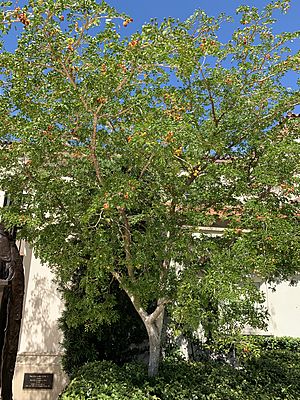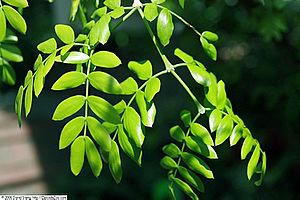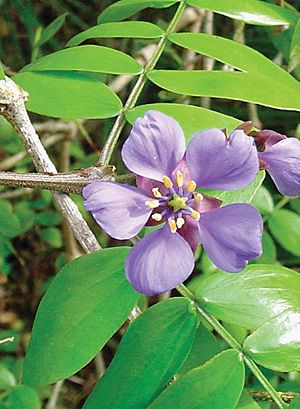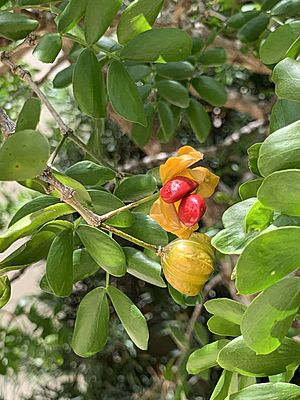Holywood facts for kids
Quick facts for kids Holywood |
|
|---|---|
 |
|
| Fruiting tree at the Society of the Four Arts, Florida | |
| Conservation status | |
| Scientific classification | |
| Genus: |
Guaiacum
|
| Species: |
sanctum
|
| Synonyms | |
|
Guaiacum guatemalense Planch. ex Rydb. |
|
The Guaiacum sanctum, also known as holywood or holywood lignum-vitae, is a type of flowering plant. It belongs to the creosote bush family, called Zygophyllaceae. This tree grows naturally in warm parts of America. You can find it from Mexico through Central America, Florida, the Caribbean, and northern South America. It has also been planted in other tropical areas around the world.
Sadly, the holywood tree is currently facing threats. Its natural home is being destroyed, which means it is now listed as near threatened on the IUCN Red List. This list tracks how close plants and animals are to becoming extinct. The Guaiacum sanctum is also special because it is the national tree of the Bahamas.
Contents
What's in a Name? The Holywood Tree's Story
The native Taíno people of the Caribbean had a special name for this tree: guayacán. The English name, "holywood," comes directly from the Spanish "palo santo," which means "holy wood." (Don't confuse it with another tree also called palo santo, Bursera graveolens!)
Writers like Francisco López de Gómara and Oviedo wrote about this specific tree in their books about the New World. It got its "holy" name during the time of the Spanish conquest. Its scientific name, Guaiacum sanctum, combines the Taíno word "guayacán" with the Latin word sanctum, meaning holy.
Discovering the Holywood Tree's Features
This small tree grows very slowly. It can reach about 7 m (23 ft) tall. Its trunk can grow to about 50 cm (20 in) wide. The tree stays green all year in most places where it grows. It can also grow well even in shady spots. Holywood trees usually start producing fruit when they are between 30 and 70 years old. They fruit during the summer months in the Northern Hemisphere.
The wood of the holywood tree is very special. It is super hard, very heavy, and even "self-lubricating." This means it's naturally slippery, which makes it useful for certain things. It has a Janka Hardness Score of 4500, making it one of the hardest woods on Earth! It's so dense that it can actually sink in water. The wood also has fine, wavy patterns on it.
What Do the Leaves Look Like?
The leaves of the holywood tree are made up of several smaller parts, called leaflets. Each leaf is about 2.5–3 cm (0.98–1.18 in) long and 2 cm (0.79 in) wide. They are a dark green color. You'll usually find three to five pairs of leaflets on each leaf. During the hottest parts of the day, these leaflets fold together to protect the tree.
Flowers and Seeds: The Holywood Tree's Reproduction
The holywood tree produces beautiful purplish-blue flowers. Each flower has five petals. They can grow alone or in small groups at the ends of the branches. These flowers have both male and female parts. After the flowers bloom, they create yellow pods. Inside these pods are black seeds, each covered in a bright red skin.
How People Use the Holywood Tree
The holywood tree is one of two species that give us a very valuable type of wood called Lignum vitae. The other species is Guaiacum officinale.
This super hard and self-lubricating wood was once used to make special parts of ships. These parts needed to last a long time and move smoothly.
People also believe this tree has medicinal value. It has been used in home remedies for a long time. In 1568, a naturalist named William Turner wrote that the plant was already growing in places like India and Sri Lanka. He noted that a broth made from it was used to treat several serious illnesses. The bark of the tree can be steeped in water to make tonics. Today, the holywood tree is also grown as an ornamental plant because of its beauty.
Protecting the Holywood Tree: Threats It Faces
The holywood tree lives in a type of rainforest called tropical-deciduous and dry forests. These forests are among the most threatened ecosystems in the world.
In the past, people cut down too many holywood trees for their valuable timber and for a special medical resin. This caused the tree to become endangered. Deforestation, which is clearing forests for things like farms and cities, also hurt the holywood tree. This has led to habitat fragmentation, meaning the tree's natural home is broken into smaller pieces. This makes it harder for the species to recover.
Because the holywood tree grows very slowly, it's hard to regrow large forests of it quickly. However, it can be grown faster if it's watered regularly and planted in well-drained soil.
Good news: the holywood tree doesn't have many major pests. Also, while there was some illegal trade of the wood in 2008, this is no longer a big threat to the species.
See also
 In Spanish: Guaiacum sanctum para niños
In Spanish: Guaiacum sanctum para niños





